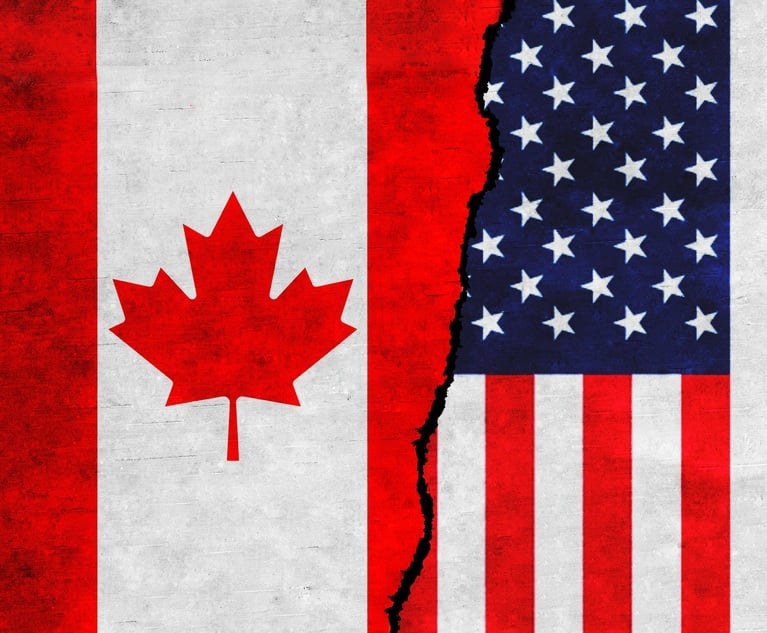Unveiled threats
Intellectual Property: Threats provisions could potentially become a thorn in the side of the Civil Procedure Rules
June 21, 2006 at 08:03 PM
4 minute read
 In its press release of 16 May, the Law Society called for the abolition of the threats provisions which apply to registered trademarks and designs. So what are these 'threats' provisions that the Law Society objects to?
In its press release of 16 May, the Law Society called for the abolition of the threats provisions which apply to registered trademarks and designs. So what are these 'threats' provisions that the Law Society objects to?
Threats provisions are statutory provisions which allow those who receive cease-and-desist letters regarding infringement of a registered trademark or a design to issue proceedings complaining about the threat against them.
Threats actions can also be brought by the recipients of patent cease-and-desist letters, although the Law Society does not discuss patents at any length in its press release (possibly because of the recent softening of the threats provisions regarding patents).
Threats made directly against manufacturers and importers of goods are not intended to be actionable, but threats made against customers or retailers are actionable – the justification is that retailers and customers should not be intimidated by unjustified threats.
Threats actions can be brought by either the customer or retailer who receives the threat, but can also be brought by the manufacturer or importer who supplied the goods to the customer or retailer. Rights owners, as well as their representatives (including lawyers and trademark and patent agents), can be sued for making the threat.
Threats actions are an ever-present concern for those who are asked to write cease-and-desist letters on behalf of their clients. Most practitioners have, at some stage, had to explain to an (understandably) confused rights owner why they may themselves be sued for asserting the intellectual property (IP) rights in which they have invested heavily.
It is a defence for the maker of the threat to show that it was not groundless. In other words, if the defendant can show that there was in fact an infringement, there will be a defence. The problem for rights holders here is that whether or not there has been an IP infringement is not a straightforward question.
It is not at all uncommon for the views of very experienced practitioners to differ. A genuine belief that there has been an infringement is not enough to justify making a threat if it turns out that the belief was misplaced.
Attempts have been made to try to get round threats actions by marking correspondence 'without prejudice' and by asserting that consideration was being given to proceedings, rather than making a direct threat. These attempts failed. Some practitioners have issued claim forms without serving them prior to sending cease-and-desist letters to enable them to argue that the threat of proceedings was not groundless. It is not clear whether this would be effective but, in any event, it does cost money. Even references to the existence of trademarks at the end of letters complaining about passing off can be held to be threats.
Kevin Martin, president of the Law Society, said: "The effect of the [threats] provisions encourages a sue-first, talk-later approach which makes mediation redundant… the Law Society is calling for the existing regime to be abolished completely. The rules are counter-productive in that they force the issue of legal proceedings rather than encour-aging dialogue and settlement."
So are the threats provisions incompatible with the overriding objective of the Civil Procedure Rules (CPR)? The answer seems to be yes.
In 2002, a committee of eminent IP practitioners was established at the request of the Law Society (although the Law Society eventually passed responsibility for it onto the Department for Constitutional Affairs) for the purposes of drafting an IP pre-action protocol. The compatibility of threats actions and the CPR was something that needed to be dealt with – while the CPR require the parties to set their cases out clearly before issuing proceedings, threats actions encourage claimants to be fearful of setting out their claim. The final draft of the protocol (which was published as a code of practice in 2004) recognises the tensions that exist and contains a health warning for practitioners about threats for those areas in which threats apply.
Although the code of practice has been well received and many practitioners have relied upon it, threats actions and the pre-action dialogue encouraged by the code of practice are uneasy bedfellows. IP practitioners will be following the progress of the Law Society's campaign with great interest to see whether this conflict can be resolved.
This content has been archived. It is available through our partners, LexisNexis® and Bloomberg Law.
To view this content, please continue to their sites.
Not a Lexis Subscriber?
Subscribe Now
Not a Bloomberg Law Subscriber?
Subscribe Now
NOT FOR REPRINT
© 2025 ALM Global, LLC, All Rights Reserved. Request academic re-use from www.copyright.com. All other uses, submit a request to [email protected]. For more information visit Asset & Logo Licensing.
You Might Like
View All
Big Law Sidelined as Asian IPOs in New York Dominated by Small Cap Listings

X-odus: Why Germany’s Federal Court of Justice and Others Are Leaving X

Mexican Lawyers On Speed-Dial as Trump Floats ‘Day One’ Tariffs

Threat of Trump Tariffs Is Sign Canada Needs to Wean Off Reliance on Trade with U.S., Trade Lawyers Say
5 minute readTrending Stories
- 1Data Disposition—Conquering the Seemingly Unscalable Mountain
- 2Who Are the Judges Assigned to Challenges to Trump’s Birthright Citizenship Order?
- 3Litigators of the Week: A Directed Verdict Win for Cisco in a West Texas Patent Case
- 4Litigator of the Week Runners-Up and Shout-Outs
- 5Womble Bond Becomes First Firm in UK to Roll Out AI Tool Firmwide
Who Got The Work
J. Brugh Lower of Gibbons has entered an appearance for industrial equipment supplier Devco Corporation in a pending trademark infringement lawsuit. The suit, accusing the defendant of selling knock-off Graco products, was filed Dec. 18 in New Jersey District Court by Rivkin Radler on behalf of Graco Inc. and Graco Minnesota. The case, assigned to U.S. District Judge Zahid N. Quraishi, is 3:24-cv-11294, Graco Inc. et al v. Devco Corporation.
Who Got The Work
Rebecca Maller-Stein and Kent A. Yalowitz of Arnold & Porter Kaye Scholer have entered their appearances for Hanaco Venture Capital and its executives, Lior Prosor and David Frankel, in a pending securities lawsuit. The action, filed on Dec. 24 in New York Southern District Court by Zell, Aron & Co. on behalf of Goldeneye Advisors, accuses the defendants of negligently and fraudulently managing the plaintiff's $1 million investment. The case, assigned to U.S. District Judge Vernon S. Broderick, is 1:24-cv-09918, Goldeneye Advisors, LLC v. Hanaco Venture Capital, Ltd. et al.
Who Got The Work
Attorneys from A&O Shearman has stepped in as defense counsel for Toronto-Dominion Bank and other defendants in a pending securities class action. The suit, filed Dec. 11 in New York Southern District Court by Bleichmar Fonti & Auld, accuses the defendants of concealing the bank's 'pervasive' deficiencies in regards to its compliance with the Bank Secrecy Act and the quality of its anti-money laundering controls. The case, assigned to U.S. District Judge Arun Subramanian, is 1:24-cv-09445, Gonzalez v. The Toronto-Dominion Bank et al.
Who Got The Work
Crown Castle International, a Pennsylvania company providing shared communications infrastructure, has turned to Luke D. Wolf of Gordon Rees Scully Mansukhani to fend off a pending breach-of-contract lawsuit. The court action, filed Nov. 25 in Michigan Eastern District Court by Hooper Hathaway PC on behalf of The Town Residences LLC, accuses Crown Castle of failing to transfer approximately $30,000 in utility payments from T-Mobile in breach of a roof-top lease and assignment agreement. The case, assigned to U.S. District Judge Susan K. Declercq, is 2:24-cv-13131, The Town Residences LLC v. T-Mobile US, Inc. et al.
Who Got The Work
Wilfred P. Coronato and Daniel M. Schwartz of McCarter & English have stepped in as defense counsel to Electrolux Home Products Inc. in a pending product liability lawsuit. The court action, filed Nov. 26 in New York Eastern District Court by Poulos Lopiccolo PC and Nagel Rice LLP on behalf of David Stern, alleges that the defendant's refrigerators’ drawers and shelving repeatedly break and fall apart within months after purchase. The case, assigned to U.S. District Judge Joan M. Azrack, is 2:24-cv-08204, Stern v. Electrolux Home Products, Inc.
Featured Firms
Law Offices of Gary Martin Hays & Associates, P.C.
(470) 294-1674
Law Offices of Mark E. Salomone
(857) 444-6468
Smith & Hassler
(713) 739-1250








